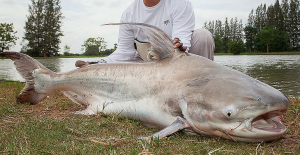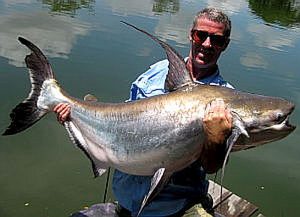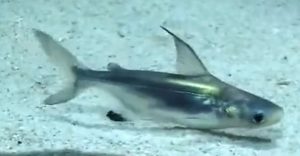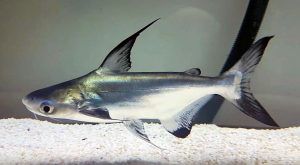The Paroon Shark (Pangasius sanitwongsei) known to tropical fish keeping enthusiasts as the Hi-fin tiger shark, Iridescent Shark, Giant Pangasius, Chao Phraya Giant Catfish, Pla Tepa, Emperor ID Shark, Hi-Fin Bull Shark, or Hi-fin Pangasius is native to the lower Mekong river which meanders through China, Thailand, Laos, Cambodia, and Vietnam and the Chao Phraya River, in Thailand.
Pangasius sanitwongsei are extremely large catfish that grow to almost 10 feet in length and have pointed, more elongated dorsal and caudal fins than Iridescent Sharks. Iridescent Sharks (Pangasius hypopthalmus) max out at a little over 4 feet in length and have rounded, more blunt dorsal and caudal fins.
Juvenile Paroon Sharks (Pangasius sanitwongsei) are frequently sold as Iridescent Sharks (Pangasius hypophthalmus) which do not grow quite as large, but still outgrow most home aquarium systems.
Second only to the giant Mekong catfish (Pangasianodon gigas) in terms of size and weight, the Paroon Shark is no doubt one of the largest freshwater fish species in the world.
Like the Iridescent Shark, the Paroon Shark is a pelagic species that inhabits the main river channels and larger tributaries of it’s range. It is a migratory species that travels upstream during the late spring and summer months to spawn.
They are a peaceful, active, skittish species that as juveniles prefer living in groups. When confined, they are easily startled and tend to jump out of their tank when spooked.
Paroon Sharks are definitely not recommended for home aquariums. If you should inadvertently purchase one as a juvenile Iridescent Shark, be prepared to continuously upgrade tank size until you must transfer it ito a pond or donate it to a public aquarium.
As juveniles, Paroon Sharks require the same husbandry as Iridescent Sharks, but they will quickly outgrow their surroundings.
Because of the size of sexually mature fish and the fact that they are a migratory species, breeding Paroon Sharks in an aquarium environment is not feasible. Despite the fact that they are bred commercially in far Eastern fish farms as a food source, their spawning conditions are virtually impossible to replicate in an aquarium of any size. It is believed that the juveniles we occasionally see for sale in the hobby are also supplied by these farms.
Even though they rarely reach their maximum size of over 10 feet in captivity, Paroon Sharks (Pangasius sanitwongsei) are still easily capable of growing several feet long. The myth that fish only grow large enough to match the size of their environment is just that, a myth. This is why we do not consider them an aquarium species.
There is good reason you never hear of any tropical fish keeping enthusiast keeping a group of adult Paroon Sharks.
Minimum Tank Size: 1,000 gal.
Care Level: Difficult
Temperament: Peaceful
Aquarium Hardiness: Hardy
Water Conditions: 72-81°F, 5-8 °d, pH 6.5 – 7.5
Max. Size: 10 feet
Color Form: Silver Black, White
Diet: Omnivore
Compatibility: Not compatible
Origin: Southeast Asia
Family: Pangasiidae
Lifespan: 20 years or more
Aquarist Experience Level: Advanced






One Response to “Paroon Shark (Pangasius sanitwongsei)”
Trackbacks/Pingbacks
[…] Iridescent Shark (Pangasius hypophthalmus) should not be confused with it’s larger cousin Pangasius sanitwongsei commonly called the Paroon Shark, Giant Pangasius, Chao Phraya Giant Catfish, Pla Tepa, Emperor ID […]